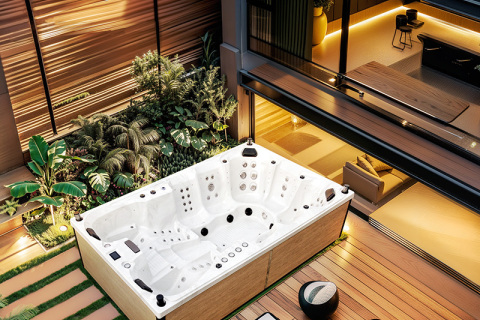
- Home
- >
- News
- >
- Industry news
- >
News
Minor cracks (surface only, less than 2cm in length and 0.5mm in width) generally do not immediately impact structural safety. However, if the cracks extend further and penetrate the fiberglass layer, structural strength may be compromised, especially if the bathtub is frequently moved or subjected to excessive weight.
Many users experience skin irritation, itching, redness, and swelling when water quality is unbalanced (especially when the pH is too acidic or when there is excess residual chlorine). Baking soda, as a weakly alkaline substance, has excellent anti-irritant properties. Its mild neutralizing properties can alleviate skin problems caused by disinfectant residue or acidic imbalances in water.
Improper installation is one of the primary factors that lead to repeated cracking in acrylic spa tubs: · The bottom of the tub is not fully in contact with the ground, resulting in uneven stress concentration in the suspended area; · Failure to use appropriate foam fillers or support frames; · Failure to account for minor unevenness in the wall or floor tiles during installation, leading to abnormal pressure points in the tub.
For common black scuff marks, you can choose a commercially available acrylic cleaner or a neutral, non-abrasive all-purpose cleaner: Steps: · Clean the stained area with a damp, soft cloth; · Spray the cleaner onto the black mark; · Gently rub with a microfiber cloth or sponge in a circular motion; · Rinse with warm water and wipe dry.
Acrylic spa bathtubs: A thick layer of acrylic (usually 2-5mm thick) is visible, with a fiberglass reinforcement layer underneath. Fiberglass bathtubs: The overall surface is thinner, with no visible acrylic panels. The interior is often a one-piece glass fiber composite material.
Thoroughly clean the acrylic spa bathtub with warm water and a neutral detergent: · Clean the surface thoroughly with a soft cloth, especially around the nozzles and crevices; · If scale is present, soak the area with a 1:1 mixture of white vinegar and water before wiping; · Avoid using harsh, corrosive cleaners containing chlorine, ammonia, or ethanol.
Maintaining cleanliness is fundamental to maintaining an acrylic spa tub and the first step to preventing material aging and system failure. 1. Frequency of Use and Cleaning Recommendations Daily Use: Clean after each use 2-3 times a week: Clean twice a week Occasional Use: Clean after each use
Coughing is a defensive reflex of the respiratory tract, intended to expel irritants, foreign matter, allergens, or excessive secretions from the airways. When someone coughs in a whirlpool spa hot tub, it often indicates that an external stimulus is affecting the airway mucosa or the lungs' sensory system.
In public, wearing a swimsuit is undoubtedly the safest option to respect others, maintain health, and maintain etiquette. In private, however, you can choose whether to wear one based on your personal preference. The ultimate goal is to ensure a comfortable and safe spa jacuzzi bathtub experience that is both personal and appropriate.
The requirement that a spa jacuzzi bathtub must be perfectly level stems from a comprehensive consideration of equipment performance, user safety, pump efficiency, and long-term maintenance costs. Whether for home or commercial use, the installation process must strictly adhere to leveling requirements. Never overlook this seemingly minor, yet crucial, technical step.
Acrylic spa tub crack repair process Step 1: Clean the cracked area Step 2: Sand the surface Step 3: Apply repair agent Step 4: Natural or heat cure Step 5: Fine sanding and polishing Step 6: Apply protective oil
The frame design of an outdoor spa hot tub is based on "bottom-load bearing." The bottom ground plane typically utilizes reinforced steel frames and support legs, capable of bearing the weight of the unit and the weight of people in use. The side structures serve only to maintain the integrity of the tub and are far less resistant to compression than the bottom.












